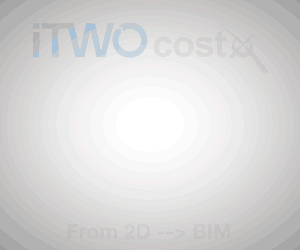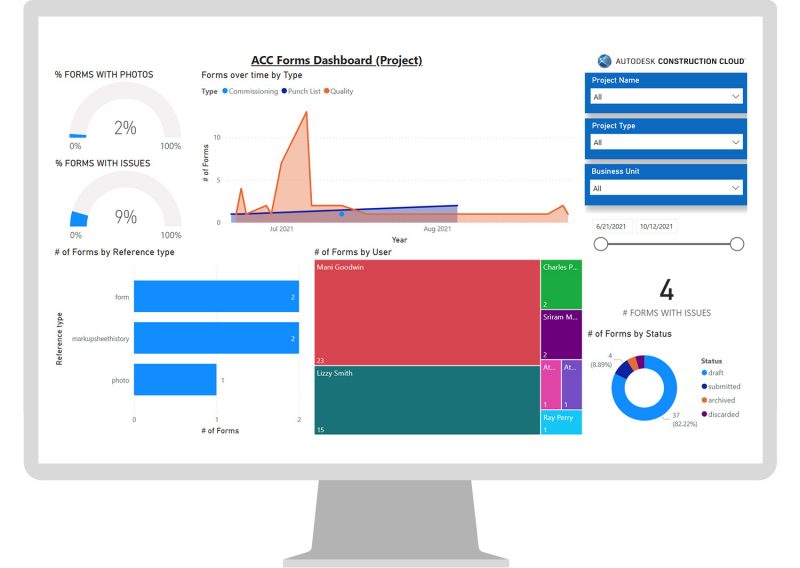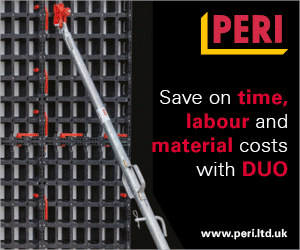Picture this. Project setbacks are no longer something to dread, instead, you’re able to navigate them with ease. Your project is on track and your entire workforce, from jobsite managers to executives in the office, are seamlessly sharing real-time data—and making great decisions because of it. Every phase of construction is on time and on budget. Sounds like a dream, right? You might be surprised to learn that this dreamscape is closer to reality than you think.
So, what holds so many construction firms back from achieving this possibility? Harnessing the Data Advantage in Construction, a global industry report made in partnership between Autodesk and FMI, uncovers some answers to this pertinent question.
According to our research, over $1.8 trillion in global construction waste may be caused due to bad data. The root of this problem is largely associated with deficiencies in the quality of data you make decisions from. In turn, this issue begs some important questions directly related to how skilled your workforce is in leveraging the plethora of data points.
s a leader or manager, ask yourself:
What kind of skills are needed to make sure my teams keep up with industry tech?Should I be investing in my teams’ data and tech skills? What does that look like?What roles should I expect to fill as construction becomes more data-driven?
To help answer these questions, we spoke with several respected technology leaders in construction. They shared their thoughts on the importance of workforce upskilling and tips for embracing the data-driven world of construction. What we found was a range of ideas for getting more value from your data, how to properly govern data, and suggestions for fostering a data-first culture. Read on for their insights.
Data skills with high value
The volume of construction data has doubled in the last three years according to our research in the data strategy report mentioned above. We asked, “What data management or analytical skills do you think will be most important in the future of the construction industry?”
Understanding the value of data in decision-making

“In general, every person should understand the value of data and data-driven decision-making. This might include how to think about what data is important for evaluating a particular business process or problem area, effective ways to visualize data, and even applying basic statistics concepts like correlations and standard deviations.” —Warren Kudman, CIO, Turner Construction Company
Making data trustworthy and easy to access

“Robust data collections and a single source of truth are critical for a successful project. The data needs to be timely and accurate. Users should be able to trust the data. In addition to this, the data entries need to be automated. People should not have to enter the same data in multiple systems.” Hrishi Maha, Leader Data Analytics and Software Development, DPR Construction
Knowing how to use new analytic technology

“Do not rely on the age-old reporting that your system is currently generating. Ask new questions about how jobs perform. Ask questions about how teams and different combinations of teams, project types, and clients all interact. Start leveraging new analytic technology to tell you where it sees issues in your business and go from there. If you just stick to the same report you have always used, you won’t see the value of the gold mine you are sitting on.” —Matt Lamb, Chief Innovation Officer, Rosendin
Ensuring data governance, stewardship and consistency

“Embedded data governance and data stewardship will be essential to ensure the credibility, quality, and security of data as the demand for self-service continues and as we become more interconnected with our partners, clients, supply-chain, and environment.”Jenny Moshea, Chief Information Officer, Sellen Construction

“As we dive deeper into data, having governance and policies associated with how data is collected, used, and shared, is crucial. Doing so involves the hiring of IT personnel with data analytics/architecture backgrounds to help wrangle the data. This is step one; without consistency, data is useless, and without governance, the associated risk is exponential.” Dan Smolilo, Director of Process and Innovation, Walsh Group
Connecting and relating data from disparate sources

“The two skills that will be paramount in the future are understanding how to connect and relate data from disparate sources. Then you need to focus on keeping controls in place so that the data stays clean and standardized for better analysis.” Travis Voss, Leader of Innovative Technology, Helm-Mechanical
Why and how to invest in data skills
Investing in skill development can help ensure your team is equipped to manage current and future challenges. Knowing where to start is often the hardest part. We asked, “Do you think construction companies should be investing in skill development (such as data management and analysis) to equip their workforce for the future? If so, where do you think firms should start?”
Education is critical to success

“We can start by understanding our current development plans and how we can provide simple introductory lessons. These lessons will help weed out the people that do not value these processes and empower the ones who do with more refined and developed courses. There are various ways to empower through education, whether it’s through local university data analytics courses, solution-specific courses (from providers like mondoDB or PowerBI), or advanced certifications courses (from solutions such as Udemy, Codecademy, or various other certification courses). Education is key to being a highly functional and top-performing company.” Dan Smolilo, Director of Process and Innovation, Walsh Group
Begin with a data strategy

“Companies should establish a data strategy and set goals, and work toward a data culture in the organization. That part is critical for becoming a data-driven company. Once the data strategy is established, the roles within data can be identified. As each organization works differently, the roles may have to be customized to suit the needs.” Hrishi Maha, Leader Data Analytics and Software Development, DPR Construction
Support high-level B.I. and analytics training

“I think [companies] should be hiring people specifically for these roles. We should be investing in some high-level training for our project teams on the importance of good data collection as well as placing controls into the systems we use to prevent bad data from being entered.” Travis Voss, Leader of Innovative Technology, Helm-Mechanical

“We should expect to support a large percentage of our staff in basic business intelligence/analytics tools so that anyone can quickly develop a visualization of their data. Of course, there will also be specialist roles that include Data Analysts and Data Engineers, who have deeper training and experience in how to build more complex analytic models.” —Warren Kudman, CIO, Turner Construction Company
Bring or build the talent in-house

“I believe there is value in every functional area across a company having a resident data analyst with data literacy skills, whether or not it is in their official job title. Someone who likes to dig into the data, understand it, question it, and be able to run simple queries to answer business questions. Incorporate data analytics skills into existing job descriptions as you look to hire new or grow existing employees. Look for folks who are curious and want to continue to grow.” Jenny Moshea, Chief Information Officer, Sellen Construction

“If construction companies don’t start building this talent in-house or bring it in from outside sooner than later, they are going to be behind the curve. It will be important to have a data analyst or scientist on staff or on retainer and a data visualization specialist to present the data in a way that it can be consumed. Companies should work with their IT departments to see what is currently available in house, what is provided through an existing consultant network or what options their ERP provider has for them with regards to data management and analytics” —Matt Lamb, Chief Innovation Officer, Rosendin
Predictions for emerging construction roles
Good data is imperitive to to decision making. Who manages the data and how continues to reveal itself as the industry evolves. So, we asked, “What type of construction roles do you expect to emerge or expand in the coming decade as construction becomes more data driven?” Here’s what was shared in our interviews.
Focus on data culture and data democratization

“We will see roles emerge in the field that drive data collection workflows whether that data comes from people, passive systems, autonomous capture, or IoT edge-connected devices. Creating a data culture that fosters data democratization so that everybody in a company, regardless of their technical know-how, can work with data comfortably and make data-informed decisions is vital.”Jenny Moshea, Chief Information Officer, Sellen Construction
Expect more data analysts and engineers

“We will see more data analysts and engineers who know how to collect, integrate, and analyze data to perform more complicated associations and correlations across individual data sets. These aren’t construction roles per se, but will support and provide additional insight to front-line construction teams” —Warren Kudman, CIO, Turner Construction Company

“I expect more data analyst roles specialized in each part of the construction life cycle to emerge.” Hrishi Maha, Leader Data Analytics and Software Development, DPR Construction

“We will start to see not only new roles but evolving roles and responsibilities such as Project Engineer – Data. Their core focus will be to leverage the data collected from jobsites to build automation and reporting modules, enabling better decision-making. We will start to also see data groups evolving within organizations that will be used as real-time construction centers. These centers will function similarly to a 911 dispatch center as they develop tools to educate us on the real-time quality, safety, performance, and profitability of our projects”. Dan Smolilo, Director of Process and Innovation, Walsh Group
Growth of the construction technology role

“I definitely think that the role of Construction Technologist that’s gotten popular in the last few years needs to continue to expand into entire teams and departments that will include business analysts and data scientists. It will be a very critical part of leading construction companies to continue to improve processes and to tease insights out of the data.” Travis Voss, Leader of Innovative Technology, Helm-Mechanical
Data specialists integrated in IT

“I don’t know if I see a whole lot of new roles emerging as we become more data-driven, but I do think we are going to see more data specialists present in IT departments. Naturally, the operations staff such as project managers and superintendents are going to have to adapt to a world that is providing them a lot more data points to accomplish their work than were present in the past.” —Matt Lamb, Chief Innovation Officer, Rosendin
What does the future of data skills look like?
We can expect to see data governance, stewardship, and consistency grow in importance as the industry embraces a data-first culture. As you’ve heard from the experts, making data work for your firm requires an investment in skills development as well as a strong foundational strategy. We’d love to hear your thoughts on the future of data-driven roles in construction. How do you see roles evolving and how can companies best upskill their workforce? Join the discussion in The Big Room, our online construction community.
Download our in-depth Data Strategy report
Harnessing the Data Advantage in Construction is a revealing report covering the true cost of bad data, and the actionable steps you can take to build a data strategy that gives you a competitive edge. The report includes guidance on establishing focal points, organizational buy-in, standardization of data and more. The report was made in partnership between Autodesk and FMI. If you’d prefer to listen, you can download the audiobook version of the report as well.
Get the Data Strategy Report
The post 6 Leaders in Construction Share Priority Data Skills to Plan for Now appeared first on Digital Builder.



































